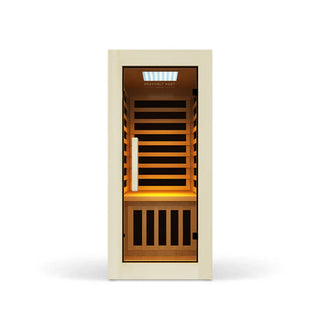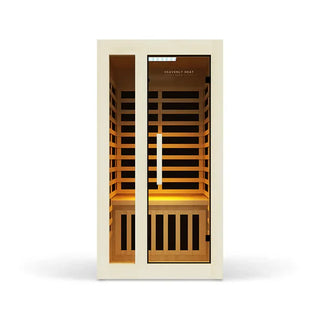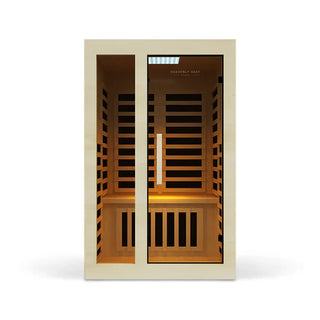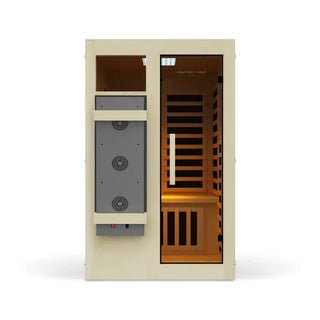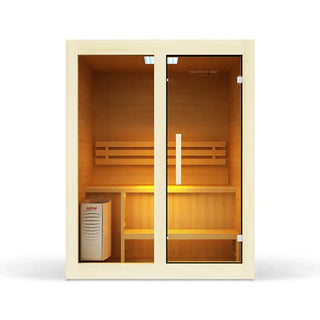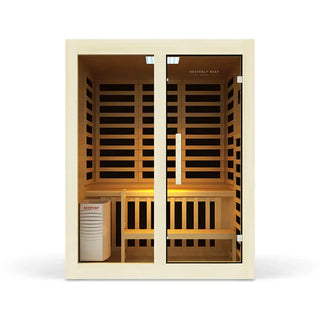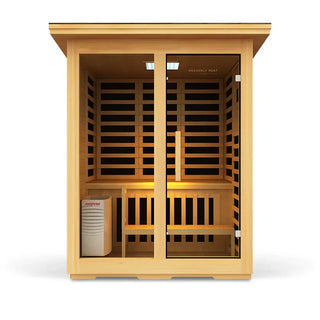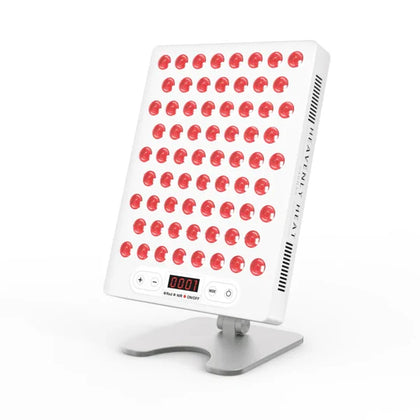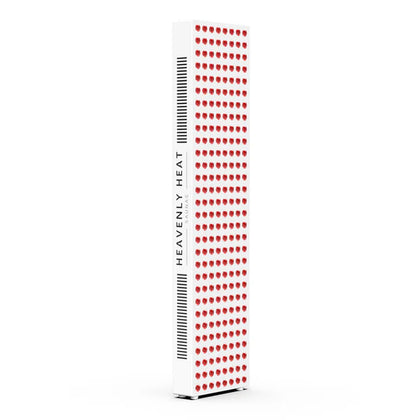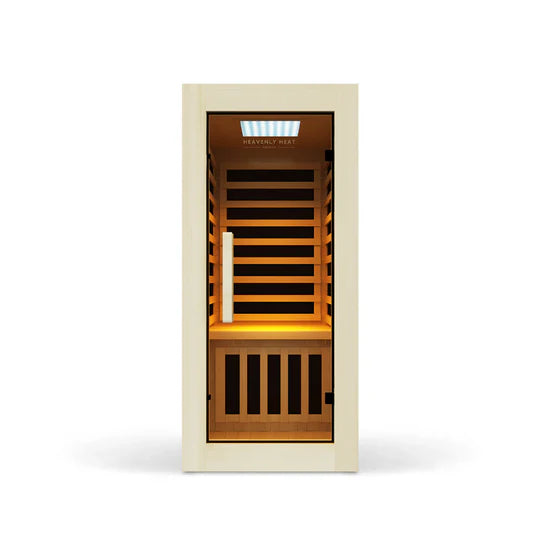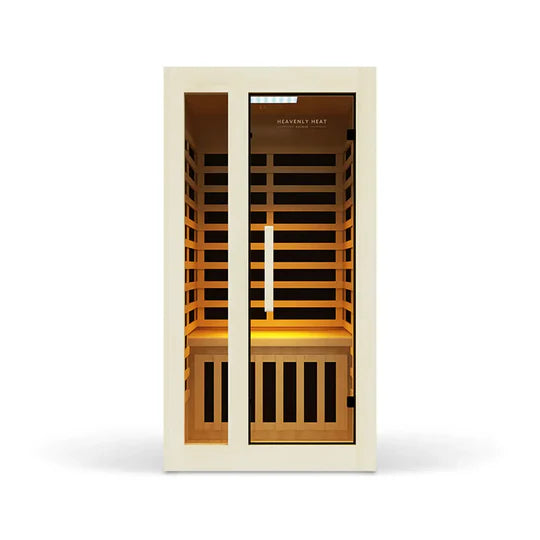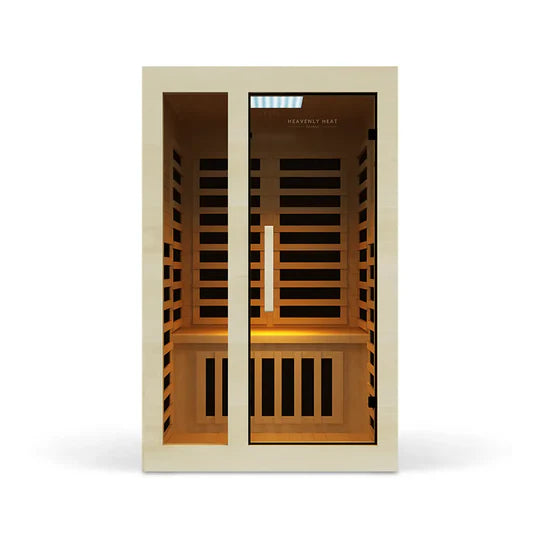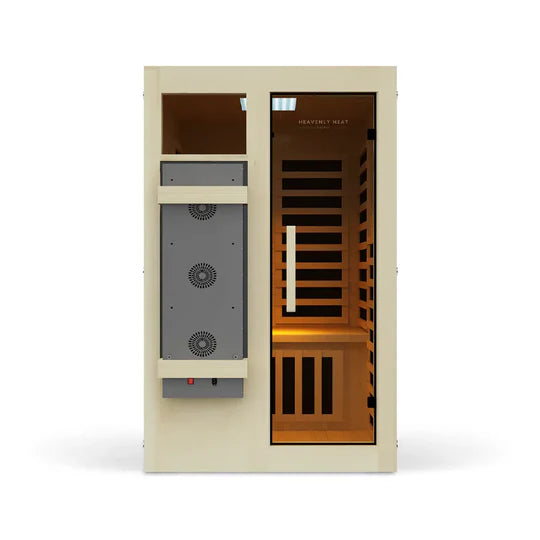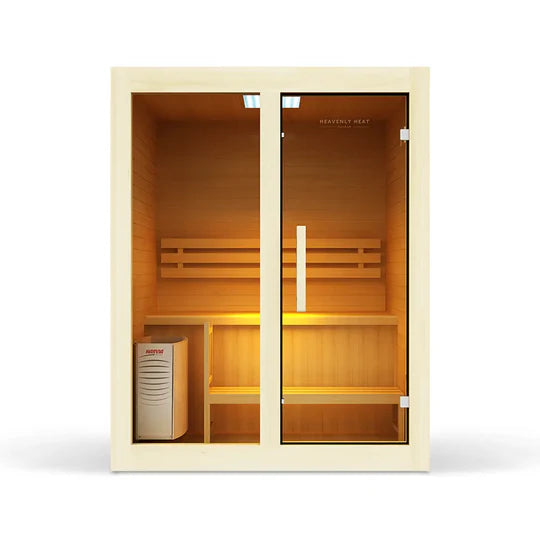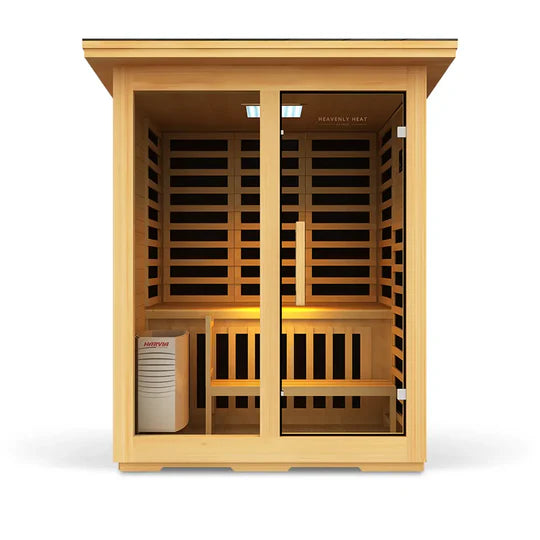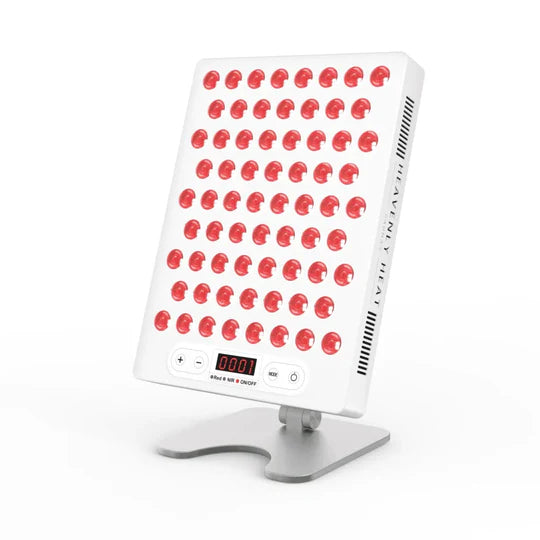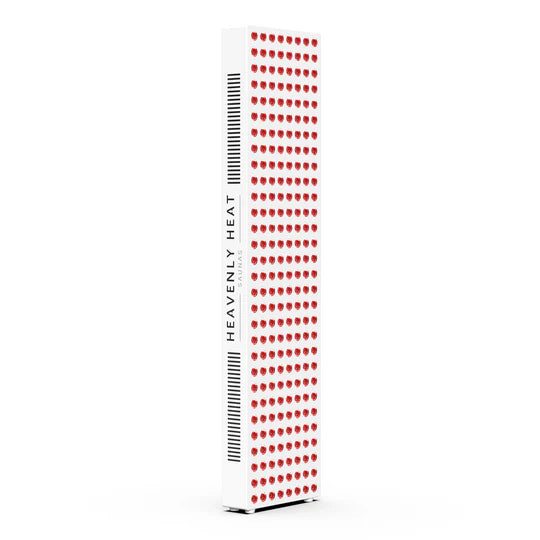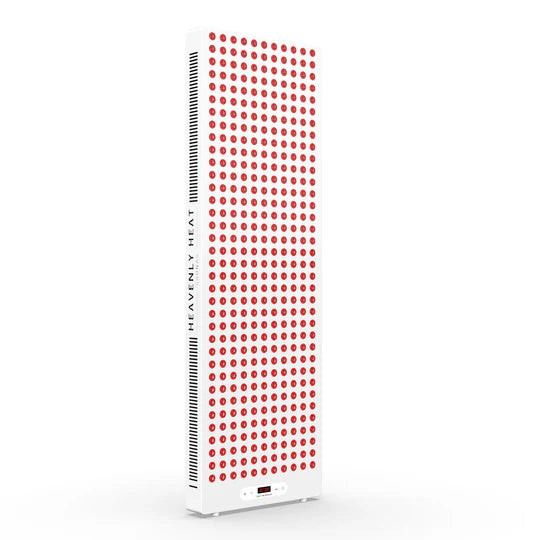How to Clean an Infrared Sauna: Wood Care & Hygiene Tips

Table of contents
A dirty sauna can harbor bacteria, reduce its effectiveness, and even cause unpleasant odors.
Ignoring regular cleaning can lead to a less relaxing and potentially unhealthy experience.
But don’t worry, keeping your infrared sauna spotless is easier than you think. Follow these simple steps for a hygienic, long-lasting sauna.

Key Takeaways
-
Prioritize Natural Cleaners: You should use gentle, non-toxic solutions like vinegar or baking soda to protect your sauna's wood.
-
Regular Wiping is Key: You must wipe down interior surfaces after each use to prevent sweat and bacteria buildup.
-
Ventilation Matters: You need to maintain proper airflow to prevent mold and odors.
-
Disinfect High-Touch Areas: You should frequently clean handles and control panels to ensure hygiene.
-
Choose the Right Tools: You should use microfiber cloths and appropriate brushes to avoid damaging the sauna's surfaces.
Must-Have Supplies for Cleaning
Soft Microfiber Cloths
- Soft microfiber cloths clean well without needing chemicals: Microfiber cloths are better than regular ones because they trap dirt and dust without harsh cleaners. Their fine fibers lift debris easily, which is perfect for sauna wood and other delicate surfaces.
- They won’t scratch your sauna while cleaning: You can safely wipe benches, walls, and glass doors with microfiber cloths. They clean gently without leaving any marks or scratches behind.
- Thick microfiber cloths soak up more and grab dirt better: High-GSM terry weave microfiber cloths are great for saunas. Their thick, looped fibers absorb moisture and pick up dust and debris more effectively than thinner cloths.
- Microfiber cloths help remove bacteria from sauna surfaces: A study tested 10 microfiber cloths and found they reduce harmful microbes like MRSA and E. coli. This makes them a hygienic choice for cleaning sauna interiors.
- Reusable cloths actually clean better after a few washes: Even though all cloths wear out a little with use, the study showed microfiber cloths improved in cleaning power after being washed properly, better than when they were brand new.
- They can be used dry or with water depending on the job: Whether you’re wiping dry dust or cleaning with water, microfiber cloths work well either way. This makes them very handy for sauna maintenance.
- Washing them the right way keeps them working like new: To keep microfiber cloths working well, wash them in warm water without using fabric softeners. Softeners can clog the fibers and reduce their ability to absorb and clean.
- Using better quality cloths means better and longer cleaning: Choose microfiber cloths with a high GSM rating. They last longer, clean better, and are tougher, a smart choice for keeping your sauna spotless over time.
Natural Wood Cleaner
- Using a natural wood cleaner keeps sauna wood safe: A natural wood cleaner is a safe, chemical-free way to clean wooden surfaces without damaging them. Regular store-bought cleaners often contain harsh chemicals that can harm sauna wood over time.
- A few kitchen ingredients are enough to make your own wood cleaner: You can make an effective wood cleaner at home using simple ingredients like white vinegar, lemon juice, and olive oil. These are gentle on wood and help keep it looking fresh.
- Mixing vinegar and essential oils makes a quick cleaner: A quick homemade recipe is one cup of water, one tablespoon of vinegar, and a few drops of essential oil. It’s easy to prepare and gentle on most wood surfaces.
- Some essential oils smell great but can irritate sensitive skin: Essential oils add a fresh scent to your cleaner, but certain ones like citrus, tea tree, or peppermint might cause skin irritation, especially for sensitive users.
- Wiping gently with a soft cloth protects the wood: Use a microfiber cloth and wipe in small, circular motions. Natural cleaners are safe for most wood, but always test on a small hidden spot first to be sure.
White Vinegar & Water Solution
- White vinegar and water together make a strong and natural sauna cleaner: A simple mix of white vinegar and water is powerful enough to clean and disinfect your sauna without any harsh chemicals. It cuts through dirt and grime with ease.
- Use more water than vinegar when you only need light cleaning: For regular, lighter cleaning jobs, mixing one part vinegar with three parts water works just fine. This softer mix is still effective and safer for frequent use.
- Don’t use this solution on stone or unsealed wooden parts: While the vinegar and water mix is safe for most surfaces, it can damage stone or unsealed wood, so avoid using it there.
- Adding essential oils can make your sauna smell fresh and clean better: A few drops of tea tree or lavender oil in your vinegar mix can boost cleaning power and leave behind a fresh scent in your sauna.
- Vinegar naturally kills bacteria without using any toxic chemicals: White vinegar is not just a cleaner, it also acts as a natural disinfectant, helping keep your infrared sauna germ-free in a safe, non-toxic way.
Hydrogen Peroxide Spray
- Hydrogen peroxide spray kills germs without choking fumes: Hydrogen peroxide spray is a powerful cleaner that eliminates germs and bacteria without harsh fumes. It works by breaking down organic matter, making it effective against mold, mildew, and stains.
- It cleans almost like bleach but doesn’t harm your health: As a household cleaner, hydrogen peroxide is almost as effective as bleach but much safer.
- You can spray it on wood, glass, and even sauna handles: You can use it on wooden surfaces, glass, and even door handles in your sauna. To disinfect, spray and let it sit for five minutes before wiping.
- Never mix it with vinegar or it can turn dangerous: Avoid mixing hydrogen peroxide with vinegar, as this creates a harmful reaction. Instead, use it separately for deep cleaning.
Baking Soda
- Baking soda removes dirt and stains without damaging surfaces: Baking soda is a natural cleaner that removes dirt, absorbs odors, and tackles stains. It works by breaking down grime without scratching surfaces.
- You avoid harmful chemicals when you clean with baking soda: Using baking soda instead of chemical cleaners reduces exposure to toxins. It’s a safer option for your home and health.
- Sprinkling baking soda helps get rid of bad smells fast: To eliminate odors, sprinkle baking soda on benches and let it sit before wiping. It naturally absorbs and neutralizes unpleasant smells.
- Mixing baking soda with vinegar makes cleaning easier: When combined with vinegar, baking soda foams up, helping lift dirt from surfaces. This reaction is great for removing stubborn grime.
- Baking soda works better when used with natural disinfectants: While baking soda doesn’t kill bacteria on its own, it helps other natural cleaners work better, making the cleaning process more effective.
- Keeping baking soda in the sauna helps stop smells right away: Keep a small container in your sauna for quick deodorizing after each use. It’s a simple way to keep it smelling clean and fresh.
Handheld Vacuum or Brush
- A handheld vacuum quickly removes dust from the sauna: When your sauna has fine dust or loose debris, a handheld vacuum gets the job done fast and keeps surfaces clean with less effort.
- A brush helps clean stubborn spots that a vacuum can't handle: For areas with sticky grime or dirt buildup, a brush works better than a vacuum by scrubbing without damaging your sauna’s surfaces.
- Soft-bristle brushes are safe for wooden benches and walls: Using a soft-bristle brush protects wood from scratches while still cleaning effectively, especially in corners or grooves.
- Microfiber cloths are great for finishing and delicate areas: After brushing or vacuuming, a microfiber cloth helps wipe down surfaces gently and adds a nice finishing touch to the cleaning.
- A brush removes pet hair better from fabrics: If there’s pet hair in your sauna, especially on fabric surfaces, a brush usually lifts it out more easily than a vacuum.
- A vacuum works better for general cleaning of upholstery: For cleaning larger fabric surfaces like cushions or padded areas, a vacuum is quicker and covers more ground than a brush.
- Having both a vacuum and a brush gives the best results: Using both tools means you’re ready for all kinds of messes, quick dust removal with a vacuum and detailed scrubbing with a brush.

Towel or Absorbent Mat
- Towels and mats are both used, but they do different jobs: Towels and absorbent mats are useful for cleaning, but they’re made for different tasks. Each one has its own advantage depending on the mess.
- Absorbent mats are better when there’s a lot of water: If there’s a lot of moisture on the floor, absorbent mats can handle it better than towels because they soak up more liquid.
- Towels are easier to wash and can be used for many things: Towels are simple to clean and can be used again and again for different cleaning jobs, which makes them more flexible than mats.
- Microfiber towels soak up more water than normal towels: Microfiber towels have tiny fibers that help them trap water better than regular cotton towels, so they dry things faster and more completely.
- Good quality towels clean better and last longer: Whether you choose cotton or microfiber, using a high-quality towel helps you clean surfaces more effectively.
- Mats protect floors by catching water before it causes damage: Putting absorbent mats on the floor helps stop water from soaking into the wood, which can prevent stains and keep things looking clean.
How Often Should You Clean Your Infrared Sauna?
- Cleaning right after every session keeps things fresh: Wiping down the benches and walls after each use removes sweat and bacteria, helping your sauna stay clean and odor-free without much effort.
- Using it every day means you should clean it deeper every week: If your sauna is part of your daily routine, doing a deeper clean once a week helps maintain good hygiene and prevents long-term buildup.
- Using it now and then? Clean it well every few weeks: If you only use the sauna occasionally, a deep clean every two to four weeks works just fine to keep it in good shape.
- Scrubbing the wood and checking for mold once a month is important: Even with regular wiping, it's important to give the wood a good scrub and check for mold monthly to protect both your health and your sauna.
- Regular cleaning makes your sauna last longer and feel better: Sticking to a cleaning routine keeps your sauna safe, comfortable, and ready to use, making every session more enjoyable.
Simple Steps to Clean Your infrared Sauna
Gather Your Cleaning Supplies
Before cleaning your infrared sauna, gather the right supplies. You’ll need a soft microfiber cloth, warm water, and a mild natural cleaner like vinegar or baking soda.
Avoid harsh chemicals that can damage the wood. Natural cleaning solutions are safer and help maintain the sauna’s finish.
A microfiber cloth is ideal because it traps dust without scratching surfaces. Before starting, make sure all supplies are within reach so you can clean efficiently without stopping.
Unplug and Let the Sauna Cool Down
Always unplug your sauna before cleaning to prevent electrical hazards. It takes about 30–60 minutes for the sauna to cool down completely.
Never clean it while it’s hot, as heat can cause cleaning solutions to evaporate too quickly, making them less effective.
Keeping the door open helps cool it faster. Unplugging the unit doesn’t speed up cooling, but it ensures safety while cleaning.
Wipe Down Interior Surfaces with a Damp Cloth
- Wiping the wood after every few uses keeps your sauna fresh: Wipe down the wooden surfaces with a damp cloth after every few uses to prevent sweat buildup and keep your sauna fresh.
- Using warm water helps clean off grime more easily: Use warm water, as cold water may not remove grime as effectively. Microfiber cloths work best since they clean without leaving streaks.
- Too much water can damage the wood over time: Be careful not to oversaturate the wood , as too much moisture can cause it to swell and lead to long-term damage when it dries.
- Drying the surfaces after wiping stops moisture from soaking in: Gently wipe the glass and metal parts as well, then always dry the wood immediately to prevent moisture from soaking in.
- Wiping regularly helps stop mold and keeps things clean: Regular wiping also helps prevent mold growth and maintains a clean, comfortable space.
Clean the Heater and Rocks (if applicable)
If your sauna has rocks, clean them occasionally to remove dust and mineral buildup.
Dust off the heater with a dry cloth or a soft brush. Avoid using water on the heater, as it may cause damage.
If the rocks appear dirty, rinse them under running water and let them dry before placing them back.
Always turn off the sauna before cleaning the heater to avoid burns or electrical issues.
Disinfect High-Touch Areas for Hygiene
Certain parts of your sauna, like door handles, benches, and the control panel, need frequent disinfection.
Wipe these areas with a mild disinfectant after each session to prevent germs from spreading.
Avoid harsh cleaners that could damage the surfaces. Use a damp cloth for the control panel, making sure not to soak it. Regularly sanitizing these areas keeps your sauna hygienic and safe to use.
Maintain Proper Ventilation and Airflow
- Leaving the door open after each session lets air flow out naturally: Good ventilation prevents musty odors and bacteria buildup in your sauna. Air it out after each session by leaving the door open for a while. This helps trapped heat and moisture escape easily.
- Dust in vents blocks air, so keep them clean regularly: Keep vents clean and free from dust. When vents are blocked, airflow slows down, making the sauna feel stuffy and increasing the chance of bad smells and germs.
- A small gap under the door helps fresh air enter without effort: A 1–2-inch gap under the sauna door allows fresh air to come in on its own. This simple detail supports steady ventilation throughout the session.
- Placing vents at top and bottom helps hot air move out properly: Install exhaust vents near both the ceiling and floor. This setup lets warm air exit and cooler air come in, keeping the inside air moving and balanced.
- Without fresh airflow, your sauna will feel stuffy and smell bad: When air doesn’t move, odors and bacteria stay inside. That’s why good airflow is key to keeping your sauna fresh, clean, and always ready to enjoy.
Establish a Regular Cleaning Routine
- Wiping the sauna after every use keeps daily dirt away: Cleaning your infrared sauna regularly prevents dirt and bacteria buildup. Wipe it down after each use to stop sweat and grime from settling in.
- Doing a deep clean once a week keeps your sauna fresh: A weekly deep clean removes anything missed during quick wipes and helps keep the sauna in great shape over time.
- A simple cleaning checklist makes the job easier to follow: Having a clear list of tasks helps you stay organized and ensures no part of the sauna is forgotten during cleaning .
- Dusting and cleaning high-touch areas should be part of your routine: Make sure to regularly dust and disinfect areas that are touched often, like the bench, handles, and control panels.
- Watching for moisture helps stop mold before it starts: Part of your routine should be checking for any signs of moisture buildup to avoid mold and keep the sauna safe.
- Using gentle cleaners protects your sauna and makes it last longer: Non-toxic and wood-safe cleaners help maintain the sauna’s natural materials and extend its lifespan.
- Drying the sauna fully after cleaning prevents future problems: Before closing the door, always let the sauna dry completely so you don’t trap moisture inside and risk mold growth.
Should You Use Store-Bought or DIY Cleaners?
- Store-bought cleaners are quick, but the chemicals might not be safe: Using a store-bought sauna cleaner saves time, but some of them have harsh chemicals that aren't ideal for infrared saunas and may affect your air quality.
- Green-labeled cleaners still need a close look at the ingredients: Even if a cleaner says “green” or “natural,” it can still have ingredients that leave unwanted residue behind. Always check the label before using it.
- Making your own cleaner gives you full control over what’s inside: When you mix your own cleaner, like vinegar and water, you know exactly what you're using. It’s safer, simple, and a lot cheaper in the long run.
- DIY cleaning saves money, but it may not remove tough stains: Homemade cleaners work well for regular cleaning, but they’re not always strong enough to handle heavy dirt or stubborn spots in your sauna.
- Your choice depends on what matters more, time or peace of mind: If saving time is your top priority, go for store-bought. If safety and savings matter more to you, DIY is the better option. It’s all about what fits your lifestyle.
How to Care for the Wood Inside Your Sauna?
Choose the Right Wood
- Choosing the right wood means picking ones that handle heat and moisture well: Cedar, hemlock, and basswood are strong choices because they don’t get damaged easily by sauna heat or moisture. They last longer and require less effort to maintain.
- The right softwood can naturally fight off bacteria: Softwoods like cedar are naturally antimicrobial, which means they help keep your sauna cleaner without needing chemicals.
- A smooth wood like basswood keeps the sauna safe and comfortable: Basswood doesn’t splinter easily, making your sauna seating and walls more comfortable and safe to touch.
- Picking the wrong wood like pine can lead to damage over time: Woods like pine are not good for saunas, they can crack, bend, or get damaged when exposed to constant heat and steam.
- Treated wood is risky because heat can release harmful fumes: Any wood with chemical finishes is unsafe for saunas. The heat can make those chemicals release fumes, which are dangerous to breathe.
- Right wood still needs care to last longer and avoid rot: Even the best sauna wood needs proper air flow and regular upkeep to stop rotting and make it last for many years.
Regular Cleaning and Maintenance
- Wiping the wood after every use keeps it clean: Cleaning benches and walls right after each session removes sweat and stops stains from forming.
- Using gentle soap protects the wood while cleaning it: For deeper cleaning, a mix of warm water and mild soap is enough, harsh chemicals can harm the wood.
- Letting the sauna dry properly keeps mold away: Good airflow and full drying after use help prevent mold and mildew from growing on the wood.
- Natural cleaners remove stains without damage: Baking soda or vinegar can clean tough spots without hurting the wood’s surface.
- Light sanding makes old wood feel new again: If parts of the wood feel rough or worn out, gentle sanding can smooth them back to life.
- Leaving the wood untreated helps it work better: Avoid using protective coatings, bare wood absorbs heat better and allows the sauna to breathe naturally.
Prevent Moisture Damage and Mold Growth
- Letting the sauna air out helps stop moisture from building up: Moisture is the biggest threat to sauna wood, making proper ventilation essential. After each session, leave the door open to air out the space, allowing excess humidity to escape.
- Checking corners often helps catch mold before it spreads: Mold often starts in hidden corners, so inspect the sauna regularly for dark spots or musty odors.
- Using natural cleaners keeps wood safe while killing mold: Natural solutions like tea tree oil or vinegar can help disinfect without damaging the wood.
- Cleaning mold early and drying the sauna stops it from coming back: If mold does appear, use a diluted hydrogen peroxide solution to remove it, then ensure the sauna dries fully before the next use.
Protect the Wood from Heat and Wear
Over time, heat can cause wood to dry out or crack. To protect the wood, avoid placing it directly in the path of infrared light for long periods.
Regularly check for signs of wear and treat areas showing signs of stress. A light sanding can smooth out rough spots, but don’t overdo it, as sanding too much will affect the wood’s natural texture and finish.
Use Safe and Effective Wood Treatment Options
- You don’t always need to treat sauna wood: Most sauna wood stays strong and beautiful on its own, but some people use treatment products to add extra protection and shine.
- Using the wrong product can cause problems: Regular oils or finishes can get sticky, hold in moisture, or give off harmful fumes when heated, so it’s important to pick one that’s made for saunas.
- Paraffin oil protects the wood without any side effects: Paraffin oil is a safe choice because it’s clear, has no smell, and doesn’t change how the wood looks or feels, just adds a layer of protection.
- A little maintenance goes a long way: Applying paraffin oil once or twice a year, after cleaning the wood, helps keep your benches in great condition for longer.
Dealing with Stains and Discoloration
- Sweat leaves marks if not cleaned properly: Sweat, moisture, and natural oils from the skin can cause discoloration over time. To remove sweat stains, scrub the affected areas with a mixture of baking soda and water.
- Mold stains need a stronger cleaning approach: Mold-related discoloration may require a stronger solution, such as diluted hydrogen peroxide.
- Leaving wood wet causes water stains: Water stains can be prevented by thoroughly drying the wood after each session.
- Dull or faded wood can look new with gentle sanding: If the wood starts to look dull, a light sanding can refresh its appearance.
- Keeping your sauna clean stops stains from building up: Regular maintenance and proper ventilation will help prevent deep stains, keeping your sauna’s interior looking clean and inviting.
Long-Term Care for Sauna Longevity
- Wiping the wood regularly helps it last longer: Cleaning your sauna’s wood once a week with a damp cloth removes dirt and buildup, which helps keep the surface in good shape over time.
- Letting out the steam protects your sauna from damage: After every use, open the door or vent to air out the sauna. This stops moisture from settling in and causing mold or wood rot.
- Adding oil brings back the wood’s natural strength: If the wood starts looking dry, rubbing it with sauna-safe oil every now and then helps restore its moisture and prevents cracking.
- Fixing small issues early avoids big repair costs later: Check for loose boards, splinters, or worn-out areas. Handling small problems right away keeps your sauna strong and safe for the future.
- Simple habits keep your sauna in great shape for years: By staying consistent with cleaning, airing out, and small fixes, you’ll keep your sauna looking and feeling like new for a long time.
Cleaning a Portable vs. Built-In Sauna
Cleaning Frequency
- Cleaning right after every session keeps dirt away: Wiping down the sauna after each use helps stop sweat and dirt from piling up. It’s a small habit that makes a big difference in keeping things clean.
- Portable saunas need a full cleaning at least once a week: Since portable saunas have fabric and hold in more moisture, they should be cleaned properly at least once a week to stop smells and bacteria.
- Built-in saunas stay cleaner longer but need a deep clean monthly: If you have a built-in sauna, a deep clean every month is enough for regular use. Wood doesn’t trap as much as fabric, but it still needs care.
- The more people use the sauna, the more often you need to clean it: When multiple people use the same sauna, sweat and germs build up faster. This means you’ll need to clean it more often than if you’re using it alone.
- High humidity and poor airflow make cleaning more important: If the sauna doesn’t have good ventilation or gets very humid, mold and bacteria grow quickly, so cleaning must be more frequent in these cases.
- Regular cleaning keeps your sauna safe and comfortable: Staying on top of cleaning stops bacteria and mold from growing. A clean sauna isn’t just nice, it’s healthier and better to relax in.
Materials
- Portable saunas need soft cleaners to stay safe: The right cleaning materials protect your sauna’s surfaces and ensure longevity. For portable saunas, mild soaps, white vinegar, and microfiber cloths work well without damaging fabric or electrical components.
- Wooden built-in saunas stay strong with gentle products: Built-in saunas, often made from cedar or hemlock, require gentle, non-abrasive cleaners to preserve the wood’s integrity.
- Strong chemicals can slowly ruin your sauna: Avoid harsh chemicals like bleach or ammonia, as they can degrade materials over time.
- Simple natural ingredients clean well without harm: Natural cleaning agents such as diluted vinegar or baking soda solutions are effective for both types, keeping your sauna fresh while minimizing exposure to harmful toxins.
Cleaning Supplies
- Using simple cleaning tools is enough for any sauna: The best cleaning supplies for saunas are basic but effective, microfiber cloths, soft brushes, and gentle disinfectants do the job without harming any surfaces.
- Infrared saunas need only non-toxic cleaners: Infrared saunas don’t require fancy products, just non-toxic cleaners that won’t mess with the heat or cause harmful fumes.
- Wood in saunas stays clean with mild soap or vinegar: To clean wooden parts, just use mild soapy water or a little diluted vinegar, harsh chemicals can damage the wood over time.
- Portable saunas stay fresh when wiped and dried well: For fabric-lined portable saunas, wiping them with a damp cloth and drying them completely helps prevent mold and bad smells.
- Outdoor saunas get dirty faster and need extra care: Because they’re exposed to weather, outdoor saunas should be cleaned more often and checked for dirt, leaves, or damage.
- More people using a sauna means stronger cleaners are needed: Whether at home or in a business, saunas used by many people need stronger disinfectants to stay hygienic and safe for everyone.
Sweat & Moisture Management
- Sweat soaks into wood, but stays on fabric: Built-in saunas absorb sweat into the wooden surfaces, while portable ones collect it on the fabric walls. This makes cleaning methods and frequency different for each type.
- Natural airflow helps built-in saunas dry faster: Built-in saunas usually dry out on their own with natural ventilation. In contrast, portable saunas often hold in the moisture and may need extra steps to fully dry.
- Wiping and airing out keeps moisture under control: Leaving the sauna open after use, wiping down sweaty surfaces, and using towels that soak up sweat can make a big difference in keeping it dry and clean.
- Damp saunas can grow bacteria and smell bad: If sweat and moisture are not handled properly, both types of saunas can start to smell, grow mold, and become unhygienic. Drying everything well after each session is a must.
Odor & Mold Prevention
- Good airflow keeps bad smells and mold away: Ventilation plays a big role in keeping your sauna fresh. Built-in saunas allow natural air movement through wooden walls, while portable saunas often trap moisture and need extra airflow to stay dry.
- Drying your sauna stops smells before they start: Letting your sauna dry properly after each use helps prevent musty odors and keeps mold from growing in damp spots.
- Vinegar is a simple way to clean and remove smells: A quick wipe with vinegar now and then can neutralize unwanted smells and act as a natural cleaner that fights mold and bacteria.
- Low humidity makes it harder for mold to grow: Mold loves moisture. By keeping humidity low and cleaning often, you create an environment where mold has a hard time surviving.
- A dehumidifier can make a big difference in wet weather: If you live in a humid place, adding a dehumidifier to your sauna setup helps remove extra moisture from the air and keeps the space dry and safe.
- Baking soda and essential oils keep your sauna smelling fresh: Baking soda absorbs odors naturally, and a few drops of essential oils can leave a clean scent, without using harsh or harmful chemicals.
Deep Cleaning Needs
- Deep cleaning means washing every part of a portable sauna: For portable saunas, deep cleaning isn’t just wiping the outside. It includes washing fabric liners, cleaning the frame, and disinfecting where you sit. These parts collect sweat and moisture and need regular, careful attention.
- Built-in saunas need special cleaning to protect the wood: Wood in built-in saunas can get damaged if you use the wrong products. Deep cleaning here means using wood-safe solutions and scrubbing properly to remove grime without hurting the surface.
- Deep cleaning goes further than your regular quick wipe: Daily maintenance helps keep your sauna fresh, but it won’t reach hidden germs. Deep cleaning is more intense, it gets rid of bacteria and buildup that normal cleaning misses.
- Using strong chemicals can ruin your sauna during deep cleaning: Harsh cleaners can damage fabric or wood and release harmful fumes. For deep cleaning, it’s safer to use natural disinfectants that clean well and protect your health.
- Regular deep cleaning keeps mold away and your sauna lasting longer: Taking time to deep clean every so often helps stop mold and keeps your sauna in great shape. It’s a simple way to make sure it lasts for years without major repairs.
Ease of Cleaning
- Portable saunas take less time to clean but need careful drying: Since they’re smaller, portable saunas can be cleaned more quickly. But the fabric and design mean you have to dry them properly after each use to avoid moisture problems.
- You don’t need to deep clean portable saunas often, but moisture still needs attention: Portable saunas usually don’t need heavy cleaning, but controlling moisture regularly is important to prevent smells and bacteria.
- Built-in saunas are bigger but the wood helps keep them clean: Even though they’re larger, built-in saunas are often easier to keep clean because the wood naturally stays hygienic if kept dry.
- Corners and wood care make built-in sauna cleaning a bit tricky: It can be harder to reach corners and maintain the wood in built-in saunas. If not cleaned properly, mold can build up over time.
- Cleaning bigger saunas needs more effort, but it’s manageable with routine: Larger saunas do take more time and energy to clean, but if you stay organized and clean regularly, it doesn’t become overwhelming.
Storage & Maintenance
- Keeping a portable sauna dry helps it last longer: Folding and storing your portable sauna in a dry place prevents moisture from building up and keeps the material in good shape over time.
- A breathable cover keeps dust away without trapping moisture: Using a light, breathable cover helps protect the sauna from dust while still allowing air to pass through, avoiding mildew.
- Storing saunas in damp places can cause mold: Avoid keeping your portable sauna in garages or basements if they’re humid, as the moisture can lead to mold and damage.
- Built-in saunas need fresh air more than storage: Since built-in saunas stay in place, focus on regular ventilation instead of storage to prevent musty smells or mildew.
- Moisture absorbers help keep the sauna fresh: Things like silica gel packs or moisture absorbers can keep both portable and built-in saunas dry when not in regular use.
- A little care keeps your sauna ready anytime: Whether portable or built-in, regular maintenance and smart storage keep your sauna clean, dry, and ready whenever you need it.
How to Sanitize Your Sauna After Illness?
Disinfect All Surfaces
- Start with the benches because that’s where most germs stay: When disinfecting your sauna, focus on benches first, they absorb the most sweat and bacteria. Use a mild, non-toxic disinfectant to avoid damaging the wood.
- Wipe walls and floors gently to avoid damaging the wood: Use a damp cloth and a soft cleaner on walls and floors. Harsh chemicals might harm the wood, so stick to something gentle that still disinfects.
- Clean the sauna rocks too because they collect germs from sweat: Even sauna rocks can hold onto bacteria. If they were exposed to sweat, they need disinfecting just like any other surface.
- Use alcohol-based cleaners carefully to protect sensitive surfaces: Alcohol disinfectants work well, but don’t use them on materials that might get damaged. Be safe and check what your sauna is made of.
- Don’t rely on heat alone because it doesn’t kill hidden germs: Sauna heat only kills germs on the surface. It won’t reach into cracks or fabrics, so proper disinfection is still a must.
Heat and Ventilate the Sauna
- Heating the sauna really hot helps kill germs: Warming up the sauna to around 150°F (65°C) is an important step to get rid of bacteria and viruses that might still be there after someone has been sick.
- Keeping it hot for 30 minutes gives time to disinfect: Let the sauna stay at this high temperature for about 30 minutes so the heat has enough time to do its job and sanitize the space properly.
- Letting fresh air in clears out bad air: After heating, open the door or windows to let clean air flow through. This helps push out any germs still floating in the air.
- Ventilating longer helps when someone was sick: If someone was recently unwell, it’s a good idea to keep the sauna open and aired out for at least 30 minutes . This helps make sure all germs are completely gone.
Clean Sauna Stones and Heater
- Cleaning sauna stones helps stop germs from spreading: Sauna stones can hold onto bacteria, especially after someone’s been sick. Taking time to clean them properly helps keep the sauna safe for everyone.
- Wiping the stones with a damp cloth is usually enough: Just remove the stones carefully and wipe each one down with a damp cloth to get rid of surface dirt and bacteria.
- Use mild disinfectant only if stones look dirty: If the stones are heavily soiled, you can use a gentle disinfectant, but stay away from strong chemicals that can ruin the stones over time.
- Be gentle when cleaning the sauna heater: Use a soft, non-scratching cloth for the heater. Don’t soak it or splash any cleaning solution directly on it, because that could cause damage.
- Steam helps a little, but it’s not enough to sanitize: Steam can support cleaning, but it won’t kill all germs. Steam machines must be used carefully, since too much moisture can harm the sauna’s electrical parts.
- Bleach should never touch delicate areas: If you’re using bleach, always follow the safety instructions. Don’t let it come into contact with heaters, wires, or other sensitive parts of the sauna.

Replace or Wash Towels and Accessories
- Towels used during sickness should not be reused: If someone has been ill, any towels they used in the sauna should be replaced right away to stop germs from spreading.
- Washing towels in hot water helps remove germs: To make sure towels are safe to use again, wash them with hot water and good detergent. A little vinegar in the wash can help kill bacteria.
- Wiping sauna accessories keeps them safe for others: Things like headrests and mats should be cleaned after each use with disinfecting wipes or a cloth and cleaning solution.
- Clean towels and accessories stop sickness from spreading: Keeping all sauna items clean protects everyone who uses the sauna from getting sick.
Common Cleaning Mistakes to Avoid
Using Too Much Cleaning Product
- Using too much cleaner doesn’t mean your sauna will be cleaner: Many people think more product gives better results, but in reality, it often does more harm than good.
- Too much cleaner leaves sticky surfaces behind: When you soak surfaces with too much product, it can leave a sticky layer that’s tough to clean and doesn’t look good.
- Strong smells from extra chemicals make the sauna unpleasant: Extra cleaning product can create a harsh chemical smell that stays around and ruins the relaxing vibe of your sauna.
- Following the right amount keeps things safe and clean: Just use the amount recommended on the label. If you’re not sure, use a bit less. This keeps your sauna clean without any side effects.
Ignoring High-Touch Surfaces
- Touching the same spots again and again spreads germs: High-touch surfaces like the sauna door handle, seats, and control panels collect dirt and bacteria quickly because everyone uses them.
- Not cleaning these surfaces can lead to illness: When these commonly used spots are ignored, germs stay behind and can easily spread from one person to another.
- A quick wipe after each use keeps things clean: Cleaning these areas right after using the sauna helps stop bacteria from building up and keeps the place safe and fresh.
- Using the right cleaner protects your sauna: Gentle cleaning products made for wood or sauna materials help clean properly without damaging anything.
- Paying attention to these spots keeps everyone healthier: By taking care of these small but important areas, you make the sauna safer and reduce the chances of people getting sick.
Not Changing Cleaning Tools Regularly
- Old cleaning tools carry germs and dirt: When you keep using the same tools, they collect bacteria, chemicals, and grime that get spread around instead of cleaned up.
- Not changing tools means cleaning becomes useless: If tools are worn out, you’re not really cleaning, you’re just moving the dirt and germs from one place to another.
- Worn tools can damage your sauna: Old scrubbers and mops can leave scratches, streaks, or marks that ruin the look and feel of your sauna surfaces.
- Replacing tools keeps your sauna truly clean: Switching out used tools at the right time makes sure your cleaning is effective and your sauna stays in great shape.
- Fresh tools make cleaning faster and easier: New tools work better and help you clean more in less time, saving your energy and giving better results.
Overlooking Proper Ventilation
- Not letting air flow while cleaning traps bad smells and moisture: Proper ventilation is key when cleaning your sauna. Without good airflow, cleaning products and moisture can get trapped, which may lead to unpleasant odors or even mold growth.
- When air doesn’t move, cleaning products don’t work well: Poor ventilation can also make it harder for cleaning products to work effectively. Products need fresh air to dry and do their job properly.
- Keeping windows open or vents running helps air move out: Keep windows open or use the sauna’s ventilation system while cleaning to ensure the air circulates properly. This helps push out moisture and lets fresh air in.
- Good airflow keeps your sauna dry and free from mold: This reduces the risk of mold and ensures that your sauna remains fresh and dry after each cleaning session. Proper airflow helps maintain a clean, healthy sauna.
Mixing Incompatible Cleaning Chemicals
- Mixing bleach with ammonia or vinegar is very dangerous: When you mix bleach with either ammonia or vinegar, it creates toxic fumes that can seriously harm your health.
- Even bleach and dish soap don’t go well together: People often think dish soap is harmless, but mixing it with bleach can release harmful gases too.
- Using one cleaning product at a time keeps you safe: To avoid dangerous reactions, always use one cleaner at a time and follow the instructions on the label.
- Wrong chemical mixes can hurt your sauna and your health: Mixing the wrong cleaning products doesn’t just risk your health, it can also damage your sauna and make it unsafe to use.
Rushing Through the Cleaning Process
- Rushing makes you miss important spots: When you clean too fast, it’s easy to skip over dirt, stains, or hard-to-reach areas, which means the job isn’t really done.
- Cleaning in a hurry can damage your surfaces: Speeding through your cleaning can lead to using too much water or the wrong tools, which might scratch or ruin delicate surfaces.
- Hurrying now creates more work later: When you overlook messy areas, you’ll end up needing to clean again soon, making your job harder in the long run.
- Taking your time keeps your sauna looking great: A slower, more focused clean helps you catch every detail and keeps your sauna in its best condition.
- A little more time means a better experience: Spending just a few extra minutes now leads to a cleaner, longer-lasting sauna that you’ll enjoy more every time.
Using the Wrong Cleaning Method for Different Surfaces
- Scrubbing wood too hard will ruin its surface: Not all surfaces are the same, wood, especially in saunas, is delicate. Using abrasive scrubbers can scratch it permanently and make it look worn out.
- Soaking fabric or carpets can lead to mold: Using too much water on fabric or carpet may seem harmless, but it creates a perfect environment for mildew and bad smells to develop.
- Hot water on wood can mess it up for good: Cleaning wood with hot water might seem like a good idea, but it often causes warping or ugly discoloration that’s hard to fix.
- Using the wrong method can do more harm than good: Every surface needs its own cleaning method. When you're unsure, the safest bet is to follow the manufacturer's cleaning instructions to avoid causing damage.
FAQs
Can Essential Oils Be Used to Clean an Infrared Sauna?
Yes, essential oils can clean an infrared sauna if used correctly. Tea tree oil disinfects with antibacterial and antifungal properties. Lemon and eucalyptus oils help remove stains and odors. Always dilute a few drops per cup of water to prevent wood damage.
How Can You Prevent Sweat Stains from Building Up in Your Sauna?
Sweat stains in an infrared sauna occur when salts and oils from sweat soak into the wood over time, causing discoloration. To prevent this, use thick towels on benches and backrests to absorb sweat and protect the wood. Showering before a sauna session removes excess oils and lotions that contribute to stains. Good ventilation helps moisture dry quickly, preventing buildup. After each session, wipe down surfaces with a clean cloth to maintain cleanliness.
Is It Safe to Use a Steam Cleaner on an Infrared Sauna?
Steam cleaning an infrared sauna can cause damage. Moisture can seep into the wood, leading to warping or cracking, and may harm the heating panels, reducing efficiency or causing failure. Excess moisture near electrical components also increases the risk of short circuits. Most manufacturers warn against steam cleaning, as it can void the warranty. Instead, use a soft cloth with natural cleaners to maintain your sauna safely.
What’s the Best Way to Remove Lingering Odors from an Infrared Sauna?
Steam cleaning an infrared sauna can cause damage. Moisture can seep into the wood, causing warping or cracking, and may harm the heating panels, reducing efficiency or causing failure. Excess moisture near electrical components also increases the risk of short circuits. Most manufacturers warn against steam cleaning, as it can void the warranty. Instead, use a soft cloth with natural cleaners to maintain your sauna safely.


